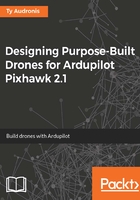
Purposes for drones
Drones are just for taking pictures, right? Wrong! Drones can be useful for just about anything and everything. Here are just a few examples:
- Suffering in a drought (hello, California) but need to water your crops? You can use a drone to map your whole farm. Then, run analysis on crop health, so that you know where to direct water. All the while sipping iced tea on your porch.
- Want to walk the golf course, but don't want to hire a caddy or carry your own clubs? Caddy drone to the rescue! Make a motorized golf trolley, and have it follow the GPS signal on your cell phone as your walk the golf course.
- Maybe you're a herpetologist on an expedition to a remote location and you found a new species of tree frog. Get it back to base-camp from miles away in an autonomous powered glider. Just load the frog into the payload bay, give it a toss above the treeline and let it fly (and land at) home! Then, just wait for base camp to get the specimen and send the powered glider back to you for your expedition to continue.
- You're a lifeguard at a beach and see someone having trouble. Launch an aerial drone that drops a boat-drone to tow the person back to shore. All the while, you don't have to leave your station (leaving the rest of the beach-goers without a lifeguard). You can meet the victim at the beach with medical supplies you may need and you're not too exhausted to help out!
The list goes on and on and on. If you can think of something requiring delivery of an item, manual labour requiring movement to another location, or just something to save time, a purpose for a drone will be found. The possibilities are quite literally limitless.
The following image shows the (Israeli Defense Force) Air Mule. It is an autonomous ambulance drone designed to go into the battlefield and airlift wounded soldiers and civilians back to a medical facility at over 100 miles per hour, all with no pilot onboard:

There is some fear that drones will eventually replace people on certain jobs. This fear is slowly being realized with autonomous cars (as UBER is talking about rolling out). After all, these are drones too. However, I prefer to think of it as freeing people from the mundane tasks in favour of the pursuit of their imaginations (like figuring out more uses for drones). Besides, people are still needed to maintain drones, monitor them, and analyse the data they provide. (At least until artificial intelligence (AI) is better at abstracting ideas and problem solving.)
It goes even further than a single drone for a single purpose though. With swarming, multiple drones can specialize in parts of a task and cooperate to achieve a very complicated result. For instance:
- Geologists deploying swarms of aerial drones to get infra-red imagery of fault lines while additional swarms of rovers (with seismic sensors) can monitor those fault lines for activity. That sort of purpose can save thousands of lives.
- Swarms of submersible micro-drones in the oceans can monitor currents and track tidal-waves headed toward land. They could even be powered using the kinetic energy of the currents to generate their electricity. People could be evacuated in time to save them.
- In the event of a natural disaster, electricity (and therefore communications) is the cause of many casualties. A swarm of communication drones (cell tower repeater replacements) can fan out across a country to re-establish the communication networks in a matter of minutes.
These are certainly some altruistic and noble uses for swarming, but the military also sees the benefit of drone swarms. The following image shows a recent test of drone swarms (deployed by dropping them from a pair of f-18 Hornets) used to map out a battle-field in real-time for mission commanders and soldiers on the ground:

Drone swarms can also be used by the entertainment industry to cover sporting events, if one drone is running low on batteries, another takes off to take its place. Drone swarms could be deployed over golf courses to help enthusiasts find their ill-hit balls that have gone off into the weeds. Farmers could use drone swarms to monitor crops, plant seeds, monitor watering patterns (and waste from evaporating water, or atomized sprinklers going into the air).
Again, the uses for drones are limitless.
We could list potential uses for drones all day, all night, every day, and every year, for our lifetimes. So, how do we realize this potential?
Well, to figure out how to make drones, we'll always first start off with how to implement existing tech and components to make what we want. The first step is to think in terms of what types of drones exist currently.